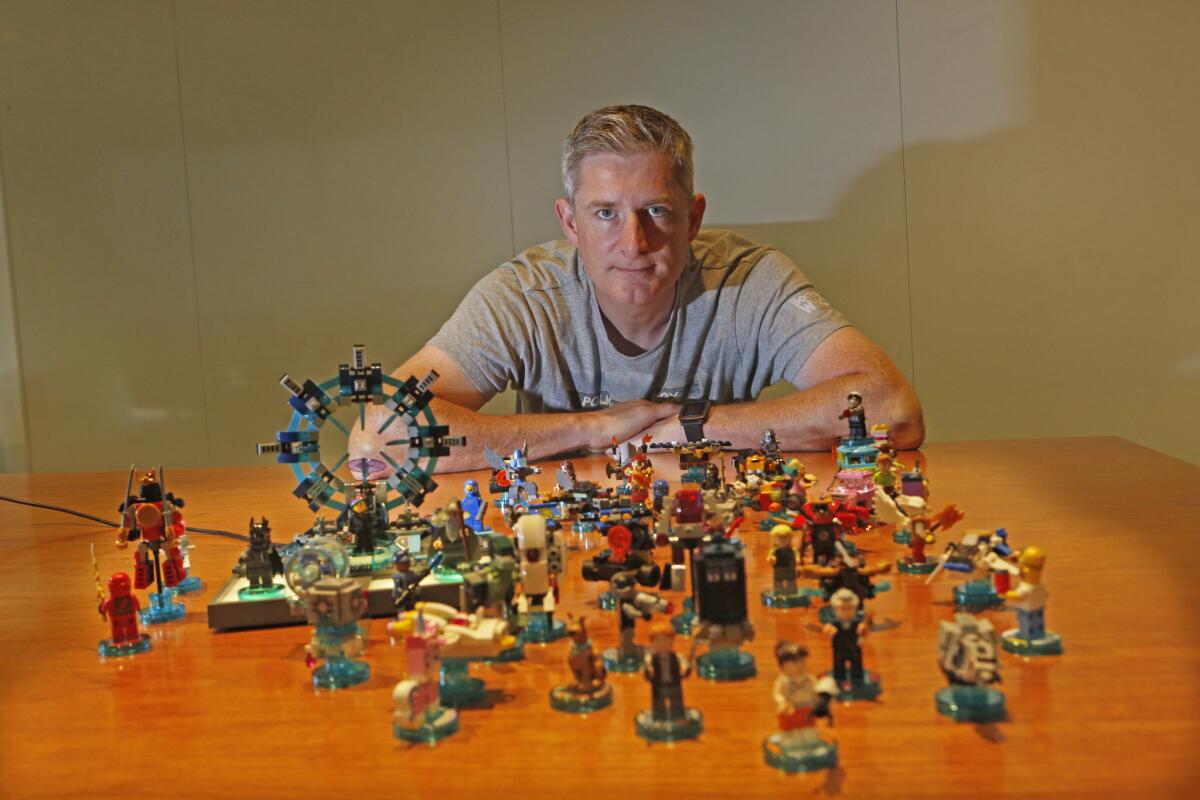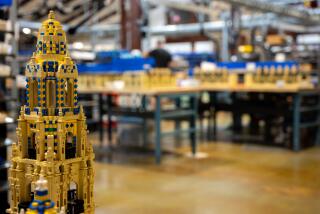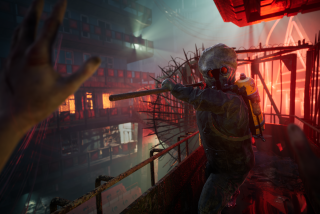Why Warner Bros. new Lego video game budget rivals what it pays for a tentpole movie

Warner Brothers executive Jon Burton poses for a portrait with his Lego Dimensions toys at Warner Brothers in Burbank on Sept. 11, 2015.
- Share via
Batman was in trouble. Not from the Joker but the Wicked Witch of the West, who was throwing everything she had at the caped crusader: fire balls, an army of dive-bombing monkeys and sinister shrieks of “I’ll get you, my pretty.”
Gandalf, the wizard from “The Lord of the Rings,” conjured a force field to protect his traveling companion, but Batman remained trapped on the yellow brick road, temporarily halting their quest to save the world.
Watching the action on screen, Jon Burton came to the rescue. The Warner Bros. executive, sitting in a studio conference room in Burbank, moved a Lego Batman mini-figure on a digital toy pad flashing a red light, instantly freeing the distressed Batman in Oz from the witch’s spell.
SIGN UP for the free Indie Focus movies newsletter >>
Burton was demonstrating “Lego Dimensions,” the latest game that debuts in stores Sunday and marks Warner Bros.’ entry into the fast-growing segment known as “toys to life.” The entertainment combines the physical world of toy figures with video game playing, mashing-up worlds and characters to mimic the way kids actually play.
“This allows us to bring a creative vision that we’ve wanted to do for years,” said Burton, founder and creative director of Warner Bros.’ TT Games. “It’s a new way to play.”
The game, which sells for about $100, attests to the rapid growth of the studio’s video games business and the growing value of the Lego brand to a studio better known for its “Harry Potter,” “Batman” and “The Lord of the Rings” movies.
The popularity of the Lego video games helped pave the way for last year’s surprise hit “The Lego Movie.” The $60-million film grossed more than $468 million worldwide and became a windfall for the Danish plastic brick maker that partners with Warner Bros. on Lego movies and video games. The companies declined to discuss how they share revenue.
Now, three other Lego movies are in the works, including a sequel to the first movie due out in 2018 and two other films. “Lego Ninjago” and “Lego Batman” are both set for release in 2017.
Warner Bros. Entertainment Chief Executive Kevin Tsujihara has made Lego an important building block in his growth plans for Hollywood’s largest movie studio, along with expanding the worlds of DC Comics and Harry Potter (through the “Fantastic Beasts” movies).
“The Lego franchise is very important to the studio across all of our businesses,” Tsujihara said in an interview. “They are now the No. 1 toy maker in the world. There’s a lot of brand affinity. There’s also a lot of great memories that parents have [with Lego]. We think there is a huge opportunity.”
Although most other major studios have retreated from the video games business, Warner Bros. has in the last eight years expanded its presence in the fast-growing, multibillion-dollar global industry, acquiring such studios as TT Games and Rocksteady Studios.
Video games sales have been a bright spot for the studio even as the box office returns this summer have been uneven.
Parent company Time Warner Inc.’s profits jumped 14% in the second quarter, fueled by a boost in video game sales from new releases “Batman: Arkham Knight” and “Mortal Kombat X.” Warner Bros. was the top U.S. video game publisher in the first half of the year, according to market research firm NPD Group.
“This is, in some sense, the third production arm of our company,” said David Haddad, executive vice president of Warner Bros. Interactive Entertainment. “Historically, we’ve been at film for a century, we’ve been at television for half a century, and now we’re going on a decade of games. We want to be in businesses that are healthy, vibrant and growing and ideally can be franchises, and that’s exactly what we’re building.”
Lego has been a key driver of the video game growth. More than 150 million video game units have been sold worldwide, led by the popularity of the Lego-themed “Batman,” “Star Wars” and “Harry Potter” games. “Lego Dimensions” is the 29th video game from the franchise.
“It’s a great new initiative,” said Niels Jørgensen, vice president of Lego Group Digital Games. “This is an important step for us in bridging the gap between physical play and digital play. We want to be where the kids are.”
Warner and Lego are late entrants into the toys-to-life category. Activision pioneered the concept in 2011 with its popular “Skylanders” game. Walt Disney Co. also has had success with “Infinity,” which was introduced in 2013 and combines characters from Disney, Marvel and Pixar movies. And Nintendo made a splash last year with its game “Amiibo.”
Still, some analysts say the business is big enough to accommodate more players.
Warner is “late to the game, but the toys-to-life category is more than $1 billion, so there is a ton of room for everyone to capture share from toys,” said Michael Pachter, an analyst at Wedbush Securities. “The Lego franchise is family friendly and a favorite of young children, and the movie and the games have brought Lego figures to life in a whole new way. I think it has tremendous value.”
Doug Creutz, a media analyst with Cowen & Co., is more cautious.
“They are trying to get into a category that already has three established players,” Creutz said. “There will be some interest in the game, but how much is to be determined. It’s going into a very crowded market.”
Burton, an industry veteran who developed such video games as “Toy Story” and “A Bug’s Life,” said “Lego Dimensions” goes well beyond what rivals have done. He cited a more elaborate toy pad — it flashes and changes color to give players clues to solve puzzles — and a range of characters and worlds that players can explore at various levels.
By buying additional “expansion packs,” players can delve into 14 adventure worlds that include characters from “The Simpsons,” “Scooby-Doo,” the TV series “Doctor Who” and the movie “Jurassic World.” The game is aimed at young children but also parents and even grandparents. “There’s a whole group of Lego gamer dads,” Burton said. “They can play with their kids.”
“Lego Dimension” was produced at TT’s studio near Manchester, England. More than 160 workers worked on the project, which took three years to develop. Warner executives declined to disclose the budget of the game but said the level of investment rivaled that of a tent pole movie.
“If we’re building something, let’s get it right, let’s not rush it to market,” said Burton, who was also an executive producer on “The Lego Movie.” “We’re maximizing the experience of what Lego is about. No one has really done this before.”
MORE:
Warner Bros. inks joint-venture deal for Chinese-language films
VR Watch: Hollywood players Disney and CAA to invest in Virtual Reality powerhouse Jaunt
Howard Rodman elected as president of the Writers Guild of America, West
More to Read
From the Oscars to the Emmys.
Get the Envelope newsletter for exclusive awards season coverage, behind-the-scenes stories from the Envelope podcast and columnist Glenn Whipp’s must-read analysis.
You may occasionally receive promotional content from the Los Angeles Times.











